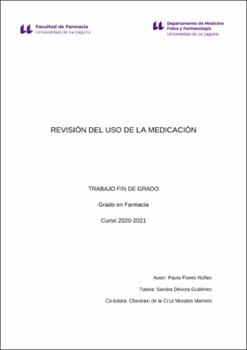Revisión del uso de la medicación
Autor
Flores Núñez, PaulaFecha
2021Resumen
Introducción: La esperanza de vida ha aumentado en los últimos años y,
con ello, las enfermedades crónicas y la prescripción de medicamentos. Esta
polimedicación puede conllevar a Problemas Relacionados con Medicamentos
(PRM) y/o Resultados Negativos Asociados a la Medicación (RNM) que
empeoran la calidad de vida de los pacientes.
Objetivos: Evaluar el grado de conocimiento que los pacientes tienen de
sus enfermedades y tratamientos asociados para identificar posibles PRM y
también, evitar y/o resolver RNM, a través de la Revisión del Uso de la
Medicación (RUM).
Material y métodos: Se realizaron dos entrevistas con el paciente en la
zona de atención personalizada (ZAP). La primera consistió en una revisión del
botiquín domiciliario, del grado de conocimiento de sus enfermedades y la
gestión de sus medicamentos. La segunda consistió en hacer entrega de un
informe con las intervenciones farmacéuticas realizadas con el usuario.
Resultados y discusión: Se incluyeron 18 pacientes, de los cuales, 3 de
ellos fueron descartados por no cumplir los criterios de inclusión y, otros 2, no se
presentaron a la primera entrevista concertada. La media de edad fue de 62,46
años ± 15,39 años. La RUM identificó, en todos los pacientes, al menos un PRM
que precisaron de una intervención farmacéutica.
Conclusión: La revisión de la medicación contribuyó a identificar PRM y
resolver RNM, así como a mejorar el conocimiento y gestión de la medicación.
Este servicio fomentó el aumentó de la adherencia terapéutica y el autocuidado
personal gracias a las medidas higiénico - dietéticas recomendadas por el
profesional sanitario. Introduction: Life expectancy has increased in recent years and, with it,
chronic diseases and drug prescription. This polypharmacy can lead to DrugRelated Problems (DRP) and / or Negative Medication-Associated Results
(NRM) that worsen the quality of life of patients.
Objectives: to evaluate the degree of knowledge that patients have of their
diseases and associated treatments to identify possible DRP and also avoid
and/or resolve NRM, through the Medication Use Review (RUM).
Material and methods: Two interviews were carried out with the patient in
the personalized attention area (ZAP). The first consisted of a review of the home
medicine cabinet, the degree of knowledge of their illnesses and the management
of their medications. The second consisted of delivering a report with the
pharmaceutical interventions carried out with the user.
Discussion and results: 18 patients were included, of which, 3 of them
were discarded because they did not meet the inclusion criteria and another 2 did
not show up for the first arranged interwiev. The mean age of the patients is 62,46
years ± 15,39 years. The RUM identified, in all patients, at least one DRP that
required a pharmaceutical intervention.
Conclusion: The review of the medication contributed to identify DRP and
resolve MRN, as well as to improve knowledge and management of medication.
This service tried to increased therapeutic adherence and personal self-care
thanks to the hygienic-dietary measures recommended by the healthcare
professional.





